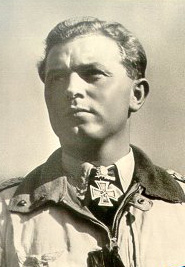Walter Oesau
| Walter Oesau | |
|---|---|

Walter Oesau
|
|
| Nickname(s) | "Gulle" |
| Born |
28 June 1913 Farnewinkel, Germany |
| Died | 11 May 1944 (aged 30) St. Vith, Belgium |
| Buried at | Friedhof Meldorf Meldorf, Germany |
| Allegiance |
|
| Service/branch |
|
| Years of service | 1933–44 |
| Rank | Oberst |
| Unit | Condor Legion, JG 1, JG 2, JG 51, Jagdgruppe 88 |
| Commands held | III./JG 3, III./JG 51, JG 2, Jagdfliegerführer Bretagne, JG 1. |
| Battles/wars |
World War II |
| Awards |
Spanish Cross in Gold with Swords and Diamonds Knight's Cross of the Iron Cross with Oak Leaves and Swords |
| Signature | |
World War II
Walter "Gulle" Oesau (28 June 1913 – 11 May 1944) was a German World War II fighter ace who served in the Luftwaffe from 1934 until his death in 1944. He rose to command Jagdgeschwader 1, which was named in his honor after his death.
He served with the Condor Legion during the Spanish Civil War, with 3 Staffel of Jagdgruppe 88 (3./J 88), claiming 8 aircraft during the campaign, becoming one of only 28 people to earn the award of the Spanish Cross in Gold and Diamonds.
At the start of World War II, Oesau was given command of 2 Staffel, Jagdgeschwader 20. The group was moved to the Eastern Front at the start of the Invasion of Poland, moving back to the Western Front later as the redesignated III Gruppe, Jagdgeschwader 51 (III./JG 51). After his first victory of World War II in the Battle of France, Oesau operated on both the Western and Eastern Fronts, where he was wounded and received the Silver Wound Badge.
He returned to operations as Geschwaderkommodore of Jagdgeschwader 1 (JG 1). He was killed in action on 11 May 1944 aged 30. JG 1 was given the suffix "Oesau" in his honor.
Walter "Gulle" Oesau was born to a bank director in Farnewinkel near Meldorf, Germany on 28 June 1913. He joined the German Army (Heer) in October 1933 and served in the Second Artillery Regiment as an enlisted soldier. After being transferred to a Luftwaffe transport unit, he undertook flying training in 1934 as a cadet (Fahnenjunker) at the Luftwaffe Academy (Deutsche Verkehrsfliegerschule) in Hanover. Upon completion of his training he was assigned to Jagdgeschwader 132, as a Leutnant. The unit was re–designated as Jagdgeschwader 2 "Richthofen" in May 1939.
...
Wikipedia
